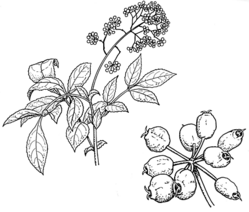
Description: Monoecious [rarely dioecious] small to large trees, or shrubs.
Leaves imparipinnate (up to 3 orders of division) [or 3-foliolate or 1-foliolate], clustered at end of branches; stipules absent or drawn into 2 small ligules, or winged and fused to the petiole; rachis nodes constricted and articulated with the petiolules.
Inflorescences terminal, compound [rarely simple] umbels or panicles [or corymbs]. Flowers aggregated into umbels or solitary; pedicellate [or sessile]; pedicels usually articulated with the ovary base, bisexual or unisexual. Calyx minutely toothed or with an undulate rim. Petals and stamens 4 or 5 [to 8 or more]. Ovary usually 2–5-locular; styles as many as ovary loculi, free or variously fused, persistent.
Fruit a succulent drupe, globose or laterally compressed.
Distribution and occurrence: World: c. 125 species, tropical & subtropical regions of Africa, South-East Asia, Australia & western Pacific (not New Zealand). Australia: 10 species (?9 species endemic, 1 species naturalized), Qld, N.S.W., Vic., N.T. [Tieghemopanax]
Text by M. J. Henwood & R. O. Makinson
Taxon concept:
Taxa not yet included in identification key
Polyscias cissodendron
| | Key to the species | |
| 1 | Flowers solitary; petiole circular in cross section | Polyscias elegans |
| Flowers aggregated into umbels; petiole U-shaped in cross section, or petiole absent | 2 |
| 2 | Trees to 20 m high; leaves petiolate; umbels arranged racemosely along inflorescence branches | Polyscias murrayi |
| Shrubs or small trees to 5 m high; leaves sessile (basal leaflets sometimes reduced and stipule-like); umbels terminate inflorescence branches
Back to 1 | Polyscias sambucifolia |
|


